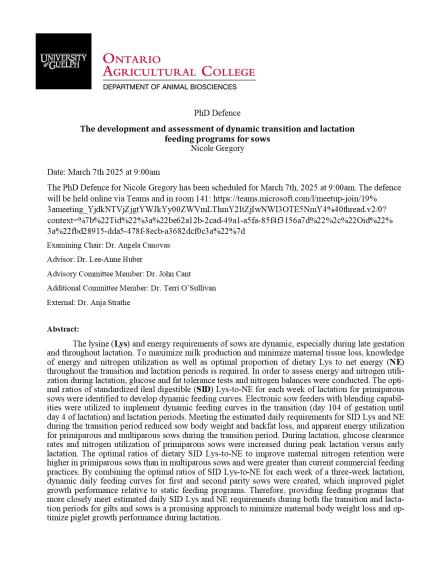Teams and room 141: https://teams.microsoft.com/l/meetup-join/19%3ameeting_YjdkNTVjZjgtYWJkYy00ZWVmLThmY2ItZjIwNWI3OTE5NmY4%40thread.v2/0?context=%7b%22Tid%22%3a%22be62a12b-2cad-49a1-a5fa-85f4f3156a7d%22%2c%22Oid%22%3a%22fbd28915-dda5-478f-8ecb-a3682dcf0c3a%22%7d

Title: The development and assessment of dynamic transition and lactation feeding programs for sows
The lysine (Lys) and energy requirements of sows are dynamic, especially during late gestation and throughout lactation. To maximize milk production and minimize maternal tissue loss, knowledge of energy and nitrogen utilization as well as optimal proportion of dietary Lys to net energy (NE) throughout the transition and lactation periods is required. In order to assess energy and nitrogen utilization during lactation, glucose and fat tolerance tests and nitrogen balances were conducted. The optimal ratios of standardized ileal digestible (SID) Lys-to-NE for each week of lactation for primiparous sows were identified to develop dynamic feeding curves. Electronic sow feeders with blending capabilities were utilized to implement dynamic feeding curves in the transition (day 104 of gestation until day 4 of lactation) and lactation periods. Meeting the estimated daily requirements for SID Lys and NE during the transition period reduced sow body weight and backfat loss, and apparent energy utilization for primiparous and multiparous sows during the transition period. During lactation, glucose clearance rates and nitrogen utilization of primiparous sows were increased during peak lactation versus early lactation. The optimal ratios of dietary SID Lys-to-NE to improve maternal nitrogen retention were higher in primiparous sows than in multiparous sows and were greater than current commercial feeding practices. By combining the optimal ratios of SID Lys-to-NE for each week of a three-week lactation, dynamic daily feeding curves for first and second parity sows were created, which improved piglet growth performance relative to static feeding programs. Therefore, providing feeding programs that more closely meet estimated daily SID Lys and NE requirements during both the transition and lactation periods for gilts and sows is a promising approach to minimize maternal body weight loss and optimize piglet growth performance during lactation.

